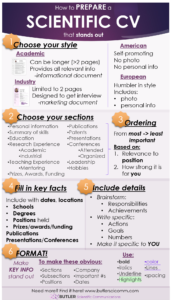Application season is going to be here before we know it, so its a great month to cover how to write a scientific CV that stands out.
To make sure we cover all of the bases, we start at the beginning with choosing your CV style and layout before moving on to the information that is included.
If you already have a draft CV, you can skip ahead, but if you are applying to positions across the pond from your normal location, don’t skip the section on US versus European CVs so you don’t accidentally make a bad impression.
Otherwise, jump to tips on:
how to perfect your written bullet points for each section
or
making readable formatting that highlights key information
or
what to do after you have a draft of your CV.
Whatever you do, don’t miss the section on how to make it yours – this is a RARELY CONSIDERED part of how to write a scientific CV that can change the game by helping you write perfectly tailored CV bullet points!
Or, for all of this in one quick infographic, skip ahead to here!
Video Series - Write your Scientific CV
This post is a also a 4-part video series on YouTube! For the first video, go here – the rest will be released shortly and linked to this video. Happy watching!
1. Choose a scientific CV style
There are a lot of different ways to style your CV, depending on which continent you are on and what type of positions you are applying to. Here we will cover the major differences there so you can pick the style that is right for you.
Academic versus Industry CV
The first major step to designing the layout of your CV is to decide where you will be using it, as how to write a scientific CV varies greatly between academia and industry.
Here are the major differences:
Academic CV
Usually longer
Frequently no limit; usually >2 pages
- Contains extensive information
Comprehensive career coverage
Very formal style
Designed to provide all the relevant information
I.e., informational document
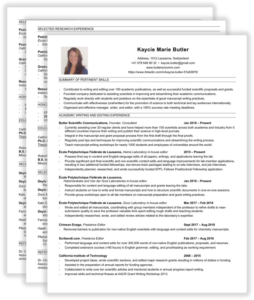
Industry CV
- Short and concise
Limited to two pages
Most relevant information ONLY
Only career points relevant to application
Can be flashy and highly personalized
Designed to convince hiring manager to interview you
i.e., marketing document, sales-y
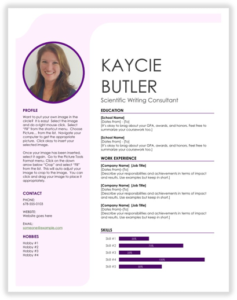
As you can see, the academic CV is usually much longer and contains all pertinent information about you as a candidate, whereas the industry CV requires you to be highly selective about the information you include.
The industry CV is also much more colorful, stylized, and has a lot more white space. The goal here is to draw the reader’s attention in key locations and make the pertinent information easy to find.
American versus European CV
If you are applying to positions across the pond, you will need to be aware of differences in CV convention between the US and Europe.
Differences here mostly focus on the use of a photo and the inclusion of personal info in Europe.
I have also personally noticed that many Europeans think the style of US CVs is too grandiose, while Americans think Europeans are too humble in their presentation. It might not seem like a huge deal, but you can improve your chances of success by knowing the style that will be expected in the place you are applying and tailoring your style to match.
How to write a scientific CV if applying across the pond from where you are:
American
Longer (3+ is fine)
Generally as detailed as possible, especially in academia
Never includes photo
NEVER includes personal info
It is illegal to hire based on these factors
Does not include hobbies/extracurriculars
Education is limited for anything 10+ years from degree
Work/research often listed before education
Starts by most recent experience
- Writing style tends to stronger self-promotion
European
Generally shorter (2-3 pages)
Limited to most relevant content, even in academia
Includes photo
Includes personal info
Gender, marital status, children, etc.
Includes hobbies and extracurriculars
Education is comprehensive, regardless of time since degree
Education often listed first
Starts from education and builds
- Writing style tends to be more humble
2. Organize and Structure your scientific CV
Choose your sections
Write a scientific CV - With a given or suggested format
Certain applications, especially for specific funding agencies, will give you either the exact CV format to use or a suggested format.
This makes it easy for you to write a scientific CV, because even if the format is only a suggestion, my best advice is to not deviate from that in the slightest!
In this way, the person reviewing your CV will know exactly where to look for the key information, and its going to make their job a lot easier. And you ALWAYS want to make the job of the person reviewing your work, no matter what type, as easy as possible!
Example: Marie Curie Fellowships
A great example here is for the Marie Curie Fellowships, which suggest the following CV sections:
At a minimum, the CV should contain:
- a) the name of the researcher
- b) professional experience (in reverse chronological order, using exact dates)
- c) education (in reverse chronological order, using exact dates)
The CV should also include information on:
1.Publications in peer-reviewed scientific journals, peer-reviewed conference proceedings, etc.
- Granted patent(s).
- Research monographs, chapters in collective volumes and any translations thereof.
- Invited presentations to internationally established conferences and/or international advanced schools.
- Research expeditions led by the experienced researcher.
- Organization of international conferences in your field(s) of research
- Examples of participation in industrial innovation.
- Prizes and Awards.
- Funding received so far.
- Supervising and mentoring activities.
My best advice here? Make your CV look EXACTLY like this, with the titles of the sections being the bolded words here.
The only exception is if you have no relevant information for a section – unless the funding agency wants you to include every section regardless, remove the ones you will not use while keeping the rest in order.
Write a scientific CV - With no given format
With no given format for your CV, you have a lot more leeway, but sometimes that makes it harder to have to decide for yourself.
In this case, I provide the most common sections here, and you can choose which ones best suit both your skills and the position you are applying for when you go to write your scientific CV.
Suggested CV sections
- Personal information
- Summary of relevant skills (optional, but I LOVE this section)
- Personalize this for each application, highlighting the 3-4 KEY points across all of your CV categories that best showcase the EXACT skills the position is seeking using the keywords used in the ad.
- Education
- Research Experience
- Academic
- Industrial
- Teaching Experience
- Prizes and Awards
- Publications
- Patents
- Presentations
- Conferences
- Attended
- Organized
- Leadership Experience
Choose your ordering
Choosing how to order your CV is important, as the closer something is to the top, the more attention it is going to receive.
Therefore, you want to order based on two key things:
- How relevant this section is for the position you are applying for
- How strong this section is for you
For me personally (and maybe its my American roots showing!), a scientific CV will always want to highlight relevant research experience first and foremost, ESPECIALLY for any research-based position. No matter what position you are applying for, your relevant experience in hands-on research will always weigh more heavily than the basic points of your educational experience.
Therefore, I generally recommend this as the first section in any CV, behind only a “Summary of relevant experiences” section, should you decide to include one.
After this, choose the ordering of your sections based on relevance to the position and showcasing your strengths.
For example, if you are applying to a position that will require you to lead projects and carry them through to completion, you might want to next highlight a strong first-author publication record, making your publication section second.
However, if your position will be teaching-heavy, instead, highlighting your teaching experience would be more important than your publications.
If you are stuck between ordering two sections, always move your strongest section first.
3. Write a Scientific CV - Fill in the content
Get the fixed facts down
Now that you are in to the body of your CV, let’s start fleshing out the sections.
The best place to start to write a scientific CV is with the facts – those parts that are fixed and where you might just need to look up exact dates or numbers.
These are usually fairly easy in terms of mental energy to get on paper and only require a bit of time.
The points you list here will also form the backbone for the more detailed bullet points that we will add next, so it is good to go into this with a list that is as comprehensive as possible.
Here, consider:
- Schools attended with years
- Degrees achieved with dates
- Research positions with titles, PI name, and dates held
- Teaching positions with titles, classes taught, and dates held
- Other relevant work experience with company name, position, and dates
- Presentations with location, title, and date
- Publications with full reference
- Prizes or awards with award name, granting organization, and date
Brainstorm your bullet points
Several of the positions listed above, especially the research, teaching, and work experience, will have a set of bullet points that expand on your role and accomplishments.
These bullet points are designed to provide:
- details about the work, project, lab, or experience
- the scope of your experience and responsibilities
- what you produced or achieved

For now, let’s start with making a list of all of the important points you want to cover. Don’t stress about how they sound right now – just get the points you want to convey down on paper.
Here, for every single position you have listed on your CV, brainstorm:
- What were the project goals and objectives?
- Were they reached?
- What were my responsibilities?
- What skills did I acquire in this position?
- What successes did I have?
- What did I overcome?
- What is the main takeaway from this position that will help me in this application?
- What exact numbers can I highlight?
- I.e., publications, patents, trainees, money raised, etc.
Take specific action to accomplish a goal
Now we focus on how to present your brainstormed points for each position – this is the nitty gritty leg work that you MUST do to write a scientific CV that really stands out and highlights YOU and YOUR accomplishments. So stick with us. 🙂
To craft key points that stand out, we are going to write each one as an actionable item. This makes our points more engaging and more powerful, so a recruiter is more likely to keep reading and remember our CV highlights.
For example, for your reserach project, did you “identify”, “develop”, “investigate”, or “discover” something?
For a list of good action words to get ideas flowing when you go to write a scientific CV, you can use this list compiled by MIT Career Advising & Professional Development: https://capd.mit.edu/sites/default/files/jobs/files/resume-action-verbs.pdf.
Try to come up with an action that YOU DID for each point you want to highlight on your CV as well as WHAT THAT ACTION ACCOMPLISHED.
Note the differences in my examples below. My original CV focused more on the PROJECT and not on my contributions, but in a CV, your contributions are actually the only part that matters.
Original CV
- One-bead-one compound (OBOC) peptide library screening for antibody-like detection agents for various diseases.
Edited CV
- Designed and synthesized antibody-like peptides for the early detection and treatment of cancer and malaria.
- Developed effective rapid-screening methodology that became the core technology still used by the lab, resulting in 2 patent filings, 8 high-level publications and an immense expansion of the project.
Do you see here how changing from a description of the project to an action verb changes the whole feel of the CV points? Now it is very clear what part I played in this project, which is what the recruiter wants to know.
Also of note, the technical term has been removed, as most people wouldn’t know it (OBOC). Here, I add this in only when needed for a position that includes screening technologies where the specific type will have meaning.
Also work to accomplish a SPECIFIC GOAL – note how much less impactful “various diseases” seems in the first point as opposed to “cancer and malaria.”
Finally, definitely write your points in a few different ways with a few different focuses – you will appreciate having these points later when you need to tailor your CV to different positions that will also have a different focus.
I actually keep several versions of different points in my master CV (see below) to pick and choose what fits best for each position.
Use specific numbers
Next, we want to write a scientific CV that is as specific as possible, so try wherever possible to get each point to a number.
How many people did you supervise or teach? How much money did you save or earn the company? How much was that grant worth? How many compounds did you synthesize? Etc.
Brainstorm as much as possible here any numbers that you can come up with to make your points more specific and informative.
Notice in my example points above, I added exactly how many papers and patents came from this project, which helps highlight the impact much more than any vaguer statement that didn’t include these numbers.
Make it YOURS!
If you take no other point from this post on how to write a scientific CV, take this one – this one little tip is very underused in CV prep, and can make all the difference in your CV.
What I want you to do:
- Read over EVERY point of your CV and estimate how many people in the world that point would apply to.
- Now, do whatever you can to make that number smaller.
Take the example of my CV above – my original text would apply to literally any person in my field. By adding specific action points and greater detail (diseases, number of publications and patents, etc.), that number should now apply to literally only me (or someone with very weirdly similar publication records).
This one trick is the best one I can give for helping make your CV specific to YOU, which it absolutely should be. Try to use this EVERYWHERE in not just your CV, but any application you submit, and see the difference!
4. Formatting: Make it skimmable and easy to find key info
Ensure key information stands out
Let’s start the formatting section with an example of my CV.
With this CV below, see how long it takes you to find:
- What year I started ButlerSciComm.
- How many academic writing positions are listed here.
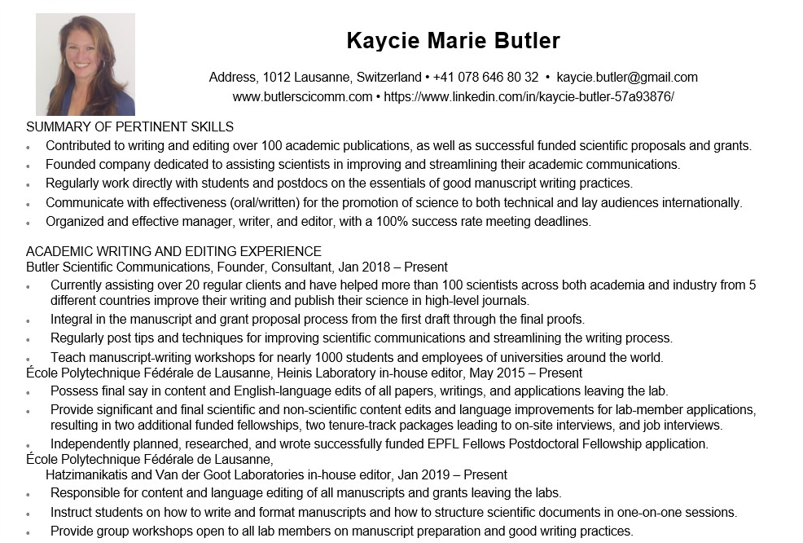
I’m going to bet it took quite a few seconds of looking to find that information, but the details like that should be INSTANTLY available to your reader.
Therefore, the next two points below are going to show you a few ways we can ensure the key information is easy to find.
Clearly delineate sections and subsections
Blocks of solid text are always difficult to read at best, but having text that is difficult to read in your CV can be detrimental in terms of the reader missing key information.
Therefore, work to break up sections in the CV to make them clear so the reader can easily find the information they need.
You want your CV to be as “skimmable” as possible, so make each section start very clear. Try to also delineate subsections (i.e., each research position you held under the Reserach Position Section) to make them easier to find.
As an example of a few different ways you can use formatting to make your section headings stand out, see this figure:
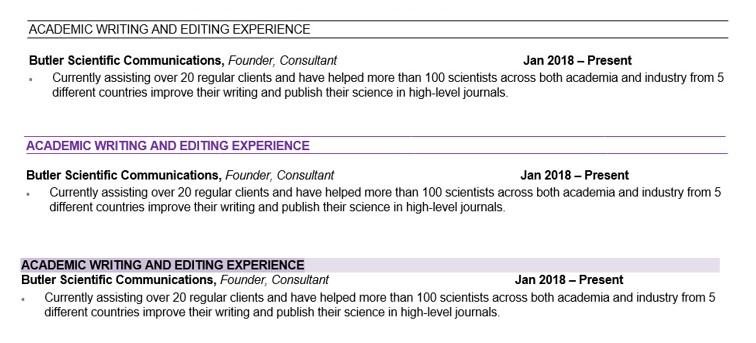
Include white space to improve readability
Just like color and formatting can be used to break up sections as discussed above, white space can also help separate key information throughout the CV.
Wherever possible, avoid large chunks of solid text, and consider the creative use of white space to help with that.
For example, you can:
- Leave a half space between lines or subsections to help delineate parts.
- Separate a position title and date held by the width of the page (white space in the middle of a line).
- Keep text left-aligned so the white space at the end of lines helps break up solid text. This also helps a reader keep track of what line they are on when reading, so its a great idea for a CV.
Don't be afraid of formatting (B, I, U, colors, etc.)
Anything that breaks up chunks of text and helps a reader find the key information is a good thing to include in your CV.
Therefore, get creative with formatting to make the key info stand out.
For example, notice in the images of my CV – for each position, I make the company name bold and my position in it is written in italics. This makes it very clear what these are for anyone skimming the CV.
Let’s do the same exercise as above – see how long it takes you to find:
- What year I started ButlerSciComm.
- How many academic writing positions are listed here.
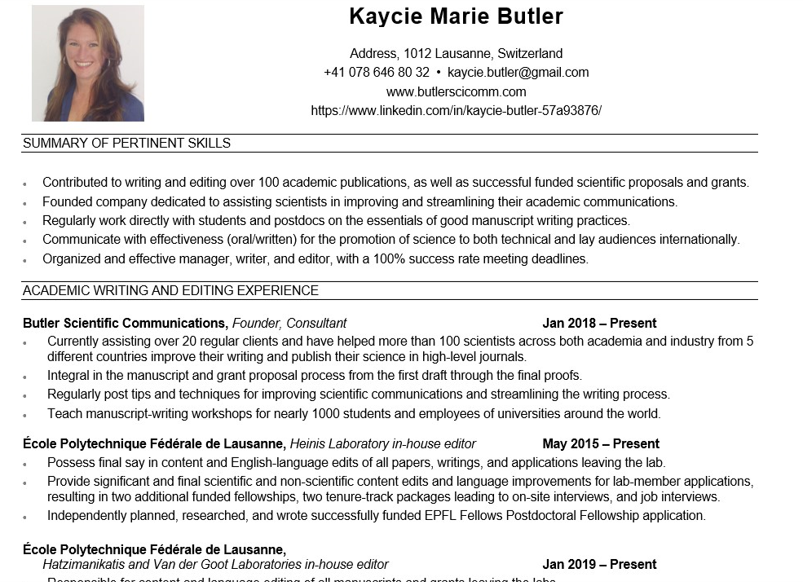
I bet you did better in finding the key information this time, and that all because of the formatting of this CV
So in seeing my CV, what can you change about your formatting when you write a scientific CV to make the key information in yours stand out?
Consider adding:
- bold text
- italics
- underline
- color
- lines
- spacing
5. Post-draft: So you have a CV draft - now what?
Get feedback on your CV
It is so easy to look at something so many times we no longer see the mistakes. Or, even worse, we no longer realize that we have missing or extraneous information that is going to be confusing.
Therefore, when you write a scientific CV, get feedback. From like, everyone.
Ask your colleagues to look over your CV and give their thoughts, but also ask friends in different fields, maybe your PI, maybe a partner or parent who is not in science at all.
You want people to help you see mistakes…but not only mistakes. You want to know what is worded awkwardly, what is not understandable, where improvements are possible, what might be missing, etc.
And the best way to do that is to get as many eyes on this as you can from people with as many different backgrounds as possible.
I know people have a tendency to be shy about things like this – I for sure was as a graduate student.
But someone is eventually going to read this CV, and its better to have people who want to help you spot these errors than a hiring manager.
Tailor your CV to EVERY application
Like hopefully you already noticed with all of the different possible formats that very based on where you are applying, your CV absolutely must be tailored specifically to each submission.
In addition to basic considerations like the format and style, not all of the information for one application is relevant for another one. And you NEVER want to give someone reviewing your CV extra unnecessary work.
To make sure that you are hitting the key points for the position when you write a scientific CV, base your CV first on the type of position.
If it is a research position, make research and publication record a focus.
If it is an industry position, highlight any previous industry work and your ability to carry projects through to completion.
For teaching positions, highlight teaching.
If you are applying based on an (funding applications count because they have a call!), use the EXACT WORDING of the call wherever possible in your own CV.
This will help in two ways:
- Because computers are often scanning CVs before a human ever sees them, you MUST have the keywords the computer is looking for.
- A human also suffers from getting tired and having tons of CVs blur – help them out by including exactly the words they are looking for so they don’t need to hunt for what they are looking for.
It doesn’t matter here what the wording is, whether they are looking for experience with a certain programming language, bacterium, technique, or phrasing, when you are highlighting that qualification anywhere on your CV, ALWAYS use their wording.

If you are having trouble with this, go through the call with a highlighter to pick out all of the key words and phrases they are looking for. Then for any that apply to you, make absolutely certain they are written in your CV exactly as they were highlighted in the call.
Keep an updated "master" CV
Because your CV is going to change for each application, and shorter CVs may be missing some key information that might be important for your next application, I highly recommend keeping a “master CV.”
Here is where you will keep detailed information about each position you’ve had, each bullet point or potentially interesting tidbit about you, but that might not fit on every CV.
My CV even has extensive and repetitive bullet points under each different reserach position so I can pick and choose the best information and wording to best highlight key points for each application I might want to submit.
With this method, every time you want to update your CV, you update the master version. Every time you apply to a job, you go to the master version and copy and paste the relevant portions into your current, specific CV.
Overall, this will help make sure you keep references of everything you’ve done, and it will save you a ton of time later as opposed to digging through stacks of old CVs to see where one specific piece of information was.
Most importantly, though, it should help ensure you are looking at all of the key points and picking out those most relevant to the position at hand.
So that's how to write a scientific CV that stands out
So, what’s next?
If you are reading this when posted (Sept 2021), then feel free to work on your own CV with us this month and post your bingo card to social media for half off a course or workshop attendance! For details – follow my twitter account.
If you need a cover letter, we have videos on writing a cover letter for submitting to a journal – its not exactly the same, but the principles still apply, and you can check that out here.

